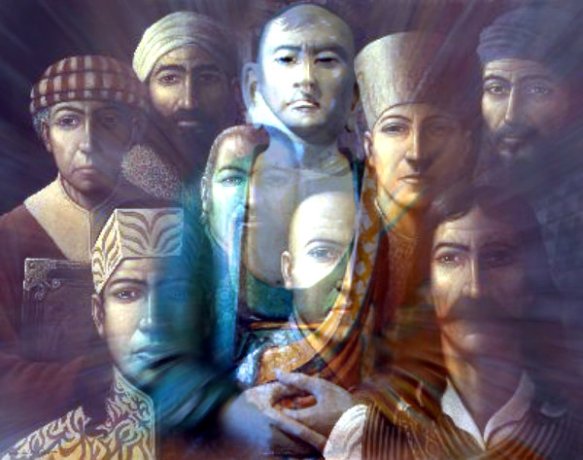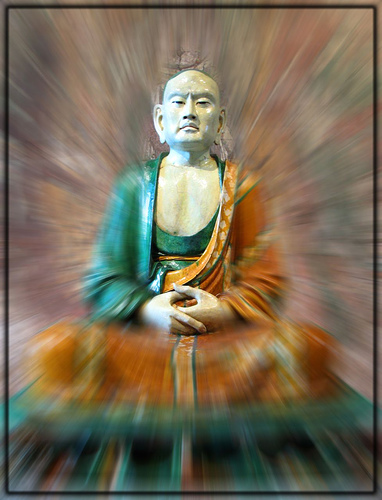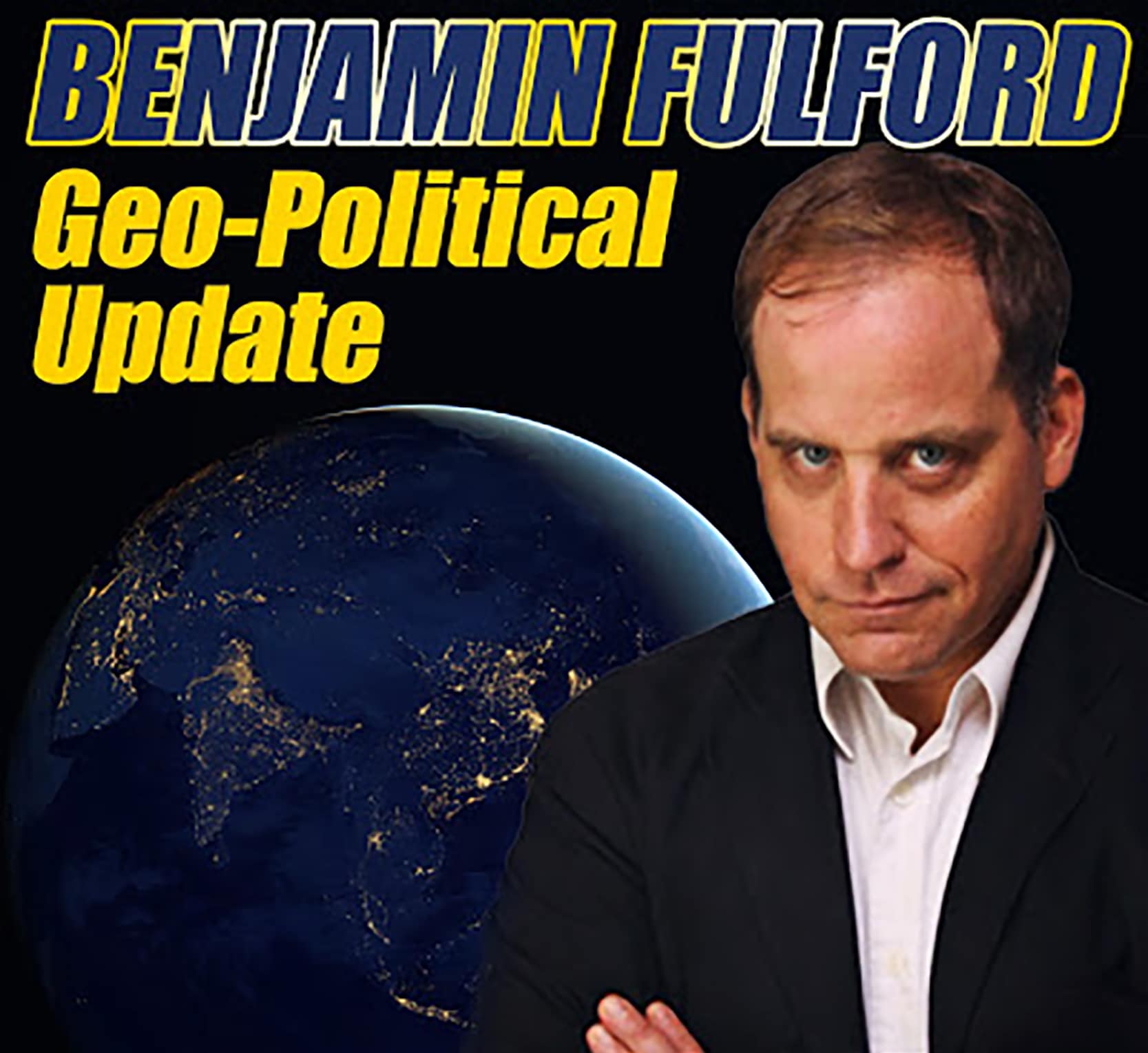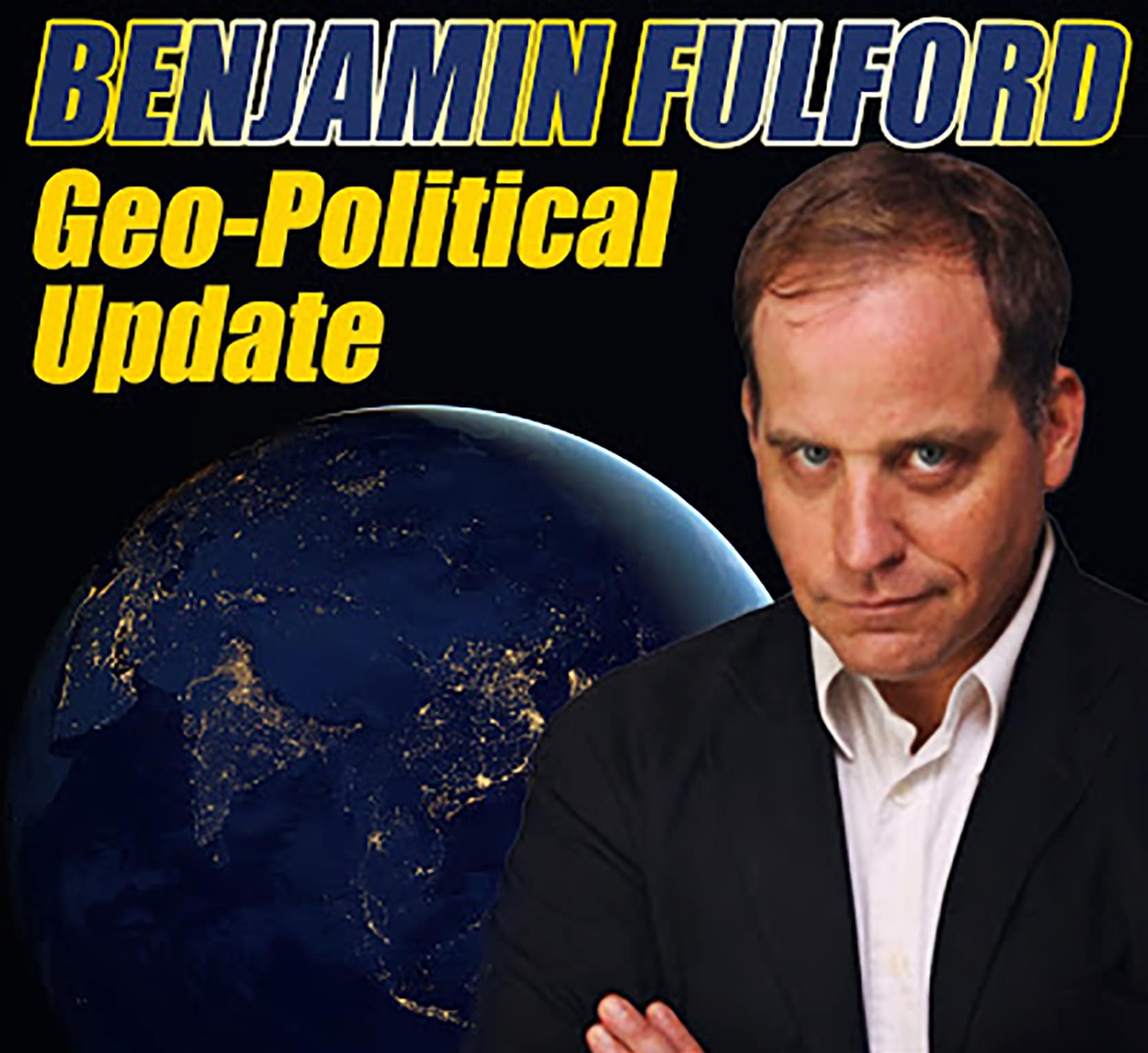THE NINE UNKNOWN MEN
The “Nine Unknown Men” are a two millennia-old secret society founded by the Indian Emperor Asoka c. 270 BCE. According to the legend, upon his conversion to Buddhism after a massacre during one of his wars, the Emperor founded the society of the Nine to preserve and develop knowledge that would be dangerous to humanity if it fell into the wrong hands. Some versions of the story include an additional motivation for the Emperor to conceal scientific knowledge: remnants of the Rama Empire, an Indian version of Atlantis, which according to Hindu scripture was destroyed by advanced weaponry 15,000 years ago.
Theories have also begun to surface claiming that Rama and Atlantis might have had war using Nuclear technology, and destroyed each other.
Among conspiracy theorists the Nine Unknown is often cited as one of the oldest and most powerful secret societies in the world. Unusually for the conspiracy subculture, the image of the group is largely though not entirely benign. Theosophists also believe the Nine to be a real organization that is working for the good of the world.
What can have been the aim of these men?Not to allow methods of destruction to fall into the hands of unqualified persons, and to pursue knowledge which would benefit mankind. Their numbers would be renewed by co-option, so as to preserve the secrecy of techniques handed down from ancient times.
Excerpts from: “The Dawn of Magic“
1960 by Louis Pauwels & Jacques Bergier
This tradition goes back to the time of Emperor Asoka, who reigned in India from 273 B.C. He was the grandson of Chandragupta who was the first to unify India. Ambitious like his ancestor whose achievements he was anxious to complete, he conquered the region of Kalinga which lay between what is now Calcutta and Madras. The Kalingans resisted and lost 100,000 men in the battle.
At the sight of this massacre Asoka was overcome. For ever after he experienced a horror of war. He renounced the idea of trying to integrate the rebellious people, declaring that the only true conquest was to win men’s hearts by observance of the laws of duty and piety, because the Sacred Majesty desired that all living creatures should enjoy security, peace and happiness and be free to live as they pleased.
A convert to Buddhism, Asoka, by his own virtuous example, spread this religion throughout India and his entire empire which included Malaya, Ceylon and Indonesia. Later Buddhism penetrated to Nepal, Tibet, China and Mongolia. Asoka nevertheless respected all religious sects. He preached vegetarianism, abolished alcohol and the slaughter of animals. H.G. Wells, in his abridged version of his Outline of World History wrote:
“Among the tens of thousands of names of monarchs accumulated in the files of history, the name of Asoka shines almost alone, like a star.”
It is said that the Emperor Asoka, aware of the horrors of war, wished to forbid men ever to put their intelligence to evil uses. During his reign natural science, past and present, was vowed to secrecy. Henceforward, and for the next 2,000 years, all researches, ranging from the structure of matter to the techniques employed in collective psychology, were to be hidden behind the mystical mask of a people commonly believed to be exclusively concerned with ecstasy and supernatural phenomena. Asoka founded the most powerful secret society on earth: that of the Nine Unknown Men.
It is still thought that the great men responsible for the destiny of modern India, and scientists like Bose and Ram believe in the existence of the Nine, and even receive advice and messages from them.
[cf. Phyllis Schlemmer’s modern “Council of Nine” which “channeling” sessions have drawn such notables as Uri Geller, physicist Dr. Andrija Puharich (who once noted that Geller’s entity was Horus/Hawk-like in appearance — another story for another time perhaps) and, of course, societal sci-fi metaprogrammer extraordinaire Gene Roddenberry -B:.B:.]
One can imagine the extraordinary importance of secret knowledge in the hands of nine men benefiting directly from experiments, studies and documents accumulated over a period of more than 2,000 years. What can have been the aim of these men? Not to allow methods of destruction to fall into the hands of unqualified persons, and to pursue knowledge which would benefit mankind. Their numbers would be renewed by co-option, so as to preserve the secrecy of techniques handed down from ancient times.
Examples of the Nine Unknown Men making contact with the outer world are rare. There was, however, the extraordinary case of one of the most mysterious figures in Western history: the Pope Sylvester II, known also by the name of Gerbert d’Aurillac. Born in the Auvergne in 920 (d. 1003) Gerbert was a Benedictine monk, professor at the University of Rheims, Archbishop of Ravenna and Pope by the grace of Otho III. He is supposed to have spent some time in Spain, after which a mysterious voyage brought him to India where he is reputed to have acquired various kinds of skills which stupefied his entourage.
For example, he possessed in his palace a bronze head which answered Yes or No to questions put to it on politics or the general position of Christianity. [cf. “Max the Crystal Skull” of current notoriety -B:.B:.] According to Sylvester II this was a perfectly simple operation corresponding to a two-figure calculation, and was performed by an automaton similar to our modem binary machines. This “magic” head was destroyed when Sylvester died, and all the information it imparted carefully concealed. No doubt an authorized research worker would come across some surprising things in the Vatican Library.
In the cybernetics journal, Computers and Automation of October 1954, the following comment appeared:
“We must suppose that he (Sylvester) was possessed of extraordinary knowledge and the most remarkable mechanical skill and inventiveness. This speaking head must have been fashioned ’under a certain conjunction of stars occurring at the exact moment when all the planets were starting on their courses.’ Neither the past, nor the present nor the future entered into it, since this invention apparently far exceeded in its scope its rival, the perverse ’mirror on the wall’ of the Queen, the precursor of our modern electronic brain. Naturally, it was widely asserted that Gerbert was only able to produce such a machine because he was in league with the Devil and had sworn eternal allegiance to him.”
Had other Europeans any contact with this society of the Nine Unknown Men?
It was not until the nineteenth century that this mystery was referred to again in the works of the French writer “Jacolliot”.
“Jacolliot” was French Consul at Calcutta under the Second Empire. He wrote some quite important prophetic works, comparable, if not superior to those of Jules Verne. He also left several books dealing with the great secrets of the human race. A great many occult writers, prophets and miracle-workers have borrowed from his writings which, completely neglected in France, are well known in Russia.
Jacolliot states categorically that the society of Nine did actually exist. And, to make it all the more intriguing, he refers in this connection to certain techniques, unimaginable in 1860, such as, for example, the liberation of energy, sterilization by radiation and psychological warfare.
Yersin, one of Pasteur and de Roux’s closest collaborators, was entrusted, it seems, with certain biological secrets when he visited Madras in 1860, and following the instructions he received was able to prepare a serum against cholera and the plague.
The story of the Nine Unknown Men was popularized for the first time in 1927 in a book by Talbot Mundy who for twenty-five years was a member of the British police force in India. His book ’The Nine Unknown’ wrote in 1927, is half fiction, half scientific inquiry.
| Perhaps the perfect balance between pulp high adventure and mystical novel was achieved in The Nine Unknown. (1923/1924), written and published right before the Tibetan opus Om. |
The novel is based on a persistent legend brought back to the west from the East, about the existence of nine unknown perfected men who watched over India, and guarded its secrets. In Mundy’s novel there turns out to be nine unknown men who work for the good of mankind, and a dark shadowy nine who worship Kali and work to destroy the work of the others.
JimGrim and his crew must try to sort out which is which if they are to survive. The novel was a favorite of Pauwels andBergier, whose discussion of “the nine” was a prototype “open conspiracy” for planetary change in their influencialMorning of the Magicians.
The use of Mundy’s ideas in Pauwels and Bergier’s book was probably was one of the prime reasons for the Mundy revival in the 1960s.
The Nine apparently employed a synthetic language [Enochian? -B:.B:.], and each of them was in possession of a book that was constantly being rewritten and containing a detailed account of some science.
[Note here the Qabbalistic “synchronicities” in the subjects of the Nine Books. -B:.B:.]
The first of these books is said to have been devoted to the technique of propaganda and psychological warfare.
“The most dangerous of all sciences,” wrote Mundy, “is that of moulding mass opinion, because it would enable anyone to govern the whole world.”
[Indeed, cf. the Rockefeller-funded exploits of such notables as Harvard’s Dr. John Mack and CSETI’s Dr. Steve Greer along with such other notables as the military/intelligence community’s Psyop (psychological warfare operative) Michael Acquino (Temple of Set), Dr. John Lilly (LSD, Dolphins’n Sensory Deprivation Tanks), The BABALON (i.e. Crowley, Parsons’n Hubbard), etc. etc. etc. -B:.B:.]
It must be remembered that Korjybski’s General Semantics did not appear until 1937 and that it was not until the West had had the experience of the last World War that the techniques of the psychology of language, i.e. propaganda, could be formulated. The first American college of semantics only came into being in 1950.
In France almost the only book that is at all well known is Serge Tchocotine’s Le Viol des Foules [i.e. “The Rape of the Masses,” no doubt a take-off on Ortega y Gasset’s classic socio-logical work of the same name. -B:.B:.] which has had a consider- able influence in intellectual political circles, although it deals only superficially with the subject.
The second book was on physiology. It explained, among other things, how it is possible to kill a man by touching him, death being caused by a reversal of the nerve-impulse. It is said that Judo is a result of “leakages” from this book.
The third volume was a study on microbiology, and dealt especially with protective colloids.
The fourth was concerned with the transmutation of metals. There is a legend that in times of drought temples and religious relief organizations received large quantities of fine gold from a secret source.
The fifth volume contains a study of all means of communication, terrestrial and extra-terrestrial. [Keep in mind this is circa 250 B.C.E. -B:.B:.]
The sixth expounds the secrets of gravitation.
The seventh contains the most exhaustive cosmogony known to humanity.
The eighth deals with light.
The ninth volume, on sociology, gives the rules for the evolution of societies, and the means of foretelling their decline.
According to theory in the Buddhist religion, there is a secret lost land where the Nine Unknown Men conduct their research for the benefit of mankind as well as keeping it hidden from them. There is also a prophecy determined by one of the Dharmic wheels (the wheel of time) that refers to an armageddon-like cosmolical spiritual challenge. It’s a rapture type event that is said to bring about the end of the world, except for the realm of Shambala is supposed to emerge and save the world from it. Shambala is the land in Buddhism that is said to be the place where people of higher life are gaining knowledge and power for this event.
A small Buddhist Stupa containing relics of Buddha, from a stupa built by Emperor Asoka in 3rd century BCE,
Recent belief speculate that this may be a lost land anywhere in the world, instead of just on top of the Himalayan mountains. The Island is the protectorate of this information, and also the prophecized land referred to in Buddhist belief. That’s why there is a security system to it, because the survivors arent supposed to be allowed to venture towards the secrets being held there
Connected with the Nine Unknown Men is the mystery of the waters of the Ganges. Multitudes of pilgrims, suffering from the most appalling diseases, bathe in them without harming the healthy ones. The sacred waters purify everything. Their strange properties have been attributed to the fact that they contain bacteriophages.
But why should these not be formed in the Bramaputra, the Amazon or the Seine? Jacolliot in his book advances the theory of sterilization by radiation, a hundred years before such a thing was thought to be possible. These radiations, he says, probably come from a secret temple hollowed out in the bed of the Ganges.
Avoiding all forms of religious, social or political agitations, deliberately and perfectly concealed from the public eye, the Nine were the incarnation of the ideal man of science, serenely aloof, but conscious of his moral obligations. Having the power to mould the destiny of the human race, but refraining from its exercise, this secret society is the finest tribute imaginable to freedom of the most exalted kind.
Looking down from the watch-tower of their hidden glory, these Nine Unknown Men watched civilizations being born, destroyed and re-born again, tolerant rather than indifferent, and ready to come to the rescue — but always observing that rule of silence that is the mark of human greatness.
The Nine Unknown
Myth or reality? A magnificent myth, in any case, and one that has issued from the depths of time — a harbinger, maybe, of the future ?
“ASOKA ‘THE GREAT“
King Asoka, the third monarch of the Indian Mauryan dynasty, has come to be regarded as one of the most exemplary rulers in world history. The British historian H.G. Wells has written: “Amidst the tens of thousands of names of monarchs that crowd the columns of history … the name of Asoka shines, and shines almost alone, like a star.”
Although Buddhist literature preserved the legend of this ruler — the story of a cruel and ruthless king who converted to Buddhism and thereafter established a reign of virtue — definitive historical records of his reign were lacking. Then in the nineteenth century there came to light a large number of edicts, in India, Nepal, Pakistan and Afghanistan. These edicts, inscribed on rocks and pillars, proclaim Asoka’s reforms and policies and promulgate his advice to his subjects. The present rendering of these edicts, based on earlier translations, offers us insights into a powerful and capable ruler’s attempt to establish an empire on the foundation of righteousness, a reign which makes the moral and spiritual welfare of his subjects its primary concern.
With the rediscovery and translation of Indian literature by European scholars in the 19th century, it was not just the religion and philosophy of Buddhism that came to light, but also its many legendary histories and biographies. Amongst this class of literature, one name that came to be noticed was that of Asoka, a good king who was supposed to have ruled India in the distant past. Stories about this king, similar in outline but differing greatly in details, were found in the Divyavadana, the Asokavadana, the Mahavamsa and several other works. They told of an exceptionally cruel and ruthless prince who had many of his brothers killed in order to seize the throne, who was dramatically converted to Buddhism and who ruled wisely and justly for the rest of his life. None of these stories were taken seriously — after all many pre-modern cultures had legends about “too good to be true” kings who had ruled righteously in the past and who, people hoped, would rule again soon. Most of these legends had their origins more in popular longing to be rid of the despotic and uncaring kings than in any historical fact. And the numerous stories about Asoka were assumed to be the same.
But in 1837, James Prinsep succeeded in deciphering an ancient inscription on a large stone pillar in Delhi. Several other pillars and rocks with similar inscriptions had been known for some time and had attracted the curiosity of scholars. Prinsep’s inscription proved to be a series of edicts issued by a king calling himself “Beloved-of-the-Gods, King Piyadasi.” In the following decades, more and more edicts by this same king were discovered and with increasingly accurate decipherment of their language, a more complete picture of this man and his deeds began to emerge.
Gradually, it dawned on scholars that the King Piyadasi of the edicts might be the King Asoka so often praised in Buddhist legends. However, it was not until 1915, when another edict actually mentioning the name Asoka was discovered, that the identification was confirmed. Having been forgotten for nearly 700 years, one of the greatest men in history became known to the world once again.
King Ashoka was responsible for a number of Indian monuments
The splendid monolithic stone pillars on which many of Ashokan inscriptions are engraved, are among the masterpieces of Indian art, and the capital atop one of them, the Sarnath Pillar, inspired the use of back-to-back lions that is the Indian national emblem (shown in the picture above.) The 24-spoked Ashoka-chakra, which has found its way into the Indian national flag also a fine artifact of Ashoka’s period.
Asoka’s edicts are mainly concerned with the reforms he instituted and the moral principles he recommended in his attempt to create a just and humane society. As such, they give us little information about his life, the details of which have to be culled from other sources. Although the exact dates of Asoka’s life are a matter of dispute among scholars, he was born in about 304 B.C. and became the third king of the Mauryan dynasty after the death of his father, Bindusara. His given name was Asoka but he assumed the title Devanampiya Piyadasi which means “Beloved-of-the-Gods, He Who Looks On With Affection.” There seems to have been a two-year war of succession during which at least one of Asoka’s brothers was killed. In 262 B.C., eight years after his coronation, Asoka’s armies attacked and conquered Kalinga, a country that roughly corresponds to the modern state of Orissa.
The loss of lives caused by battle, reprisals, deportations and the turmoil that always exists in the aftermath of war so horrified Asoka that it brought about a complete change in his personality. It seems that Asoka had been calling himself a Buddhist for at least two years prior to the Kalinga war, but his commitment to Buddhism was only lukewarm and perhaps had a political motive behind it. But after the war Asoka dedicated the rest of his life trying to apply Buddhist principles to the administration of his vast empire. He had a crucial part to play in helping Buddhism to spread both throughout India and abroad, and probably built the first major Buddhist monuments. Asoka died in 232 B.C. in the thirty-eighth year of his reign.
https://shanepedia.wordpress.com








Replies
So they're super secret, yet now the whole world knows about them. Uh huh.
The greatest secret society is my mind . .. .. . ...... muahahahhahahahha ah oh my toe :(
yes there are many of us
legionsi suppose
Finally a secret society so secret it´s actually discovered honesty.
yea ... it is said that the Ashoka group (which apparently still functions) are responsible for the rise of Hitler - http://www.oshonews.com/2013/08/adolf-hitler-group-of-ashoka/ - who knows what else they have in mind ... ;))
Thanks Kalki ...
Firstly nice to hear from you Ara. I read through the info provided by your link but I don't think the magnificent 9 were behind Hitlers rise and fall for I feel the magnificent 9 will work for the highest good of the inhabitants of Mother Earth and for the highest good of Morher Earth. These magnificent 9 are connected to the source as they have the sword of true secret knowledge and with that they will help to reconnect others to the source.
Well Ara who knows that I might be one of the nine ..well don't tell anybody OM SHANTI OM
Thank you Kalki ... ;))
sure anything is possible!